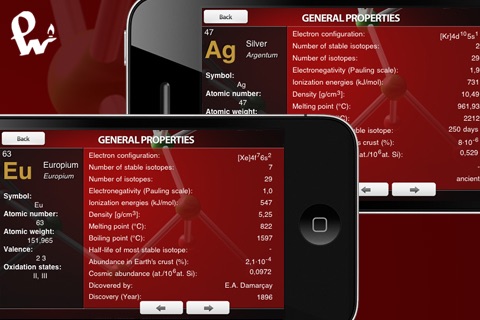
Periodic Table - PWN app for iPhone and iPad
Developer: Wydawnictwo Naukowe PWN & RosMedia
First release : 10 May 2011
App size: 9.6 Mb
Periodic Table Application
The application allows browsing through 114 chemical elements on the periodical table in two modes: whole table view mode and single element view mode. The application also allows searching the elements according to name or browse through their list in alphabetical order.
* Whole Table View Mode.
The mode allows us to magnify or minimize the periodical table. The elements’ symbols and their atomic number are visible on individual cells of the periodical table. Background colour of individual cell is dependent on a parameter value currently selected for a colour scale. We have a possibility to set a colour scale according to the following parameters:
- Atomic number;
- Atomic mass;
- Number of stable isotopes;
- Number of known isotopes;
- Electronegativity (according to Paulin);
- Ionization energy (kJ/mol);
- Density;
- Melting point (C);
- Boiling point (C);
- Contents in lithosphere (%), and
- Cosmic abundance.
* Single Element View Mode.
We can also review other data for each element (other than listed above), such as: Polish name, Latin name, valence, oxidation state, electron configuration, half-life period of the most stable isotope, discoverer and year of discovery.
* Game Mode.
The aim of the game is to put the complete periodical table in order according to its symbol and electron configuration in the basic state (i.e. in the lowest energy state). Put a drawn element plate in a right place on the periodical table. If the place is correct, the plate ‘jumps into’ the cell, if not, another element plate is drawn.
All the elements are divided into several groups of different difficulty levels. Drawing another element takes place within the frames of the lowest difficulty level group with elements that have not been placed on the table during the same game session.
ABOUT PWN:
Polish Scientific Publishers PWN/ Wydawnictwo Naukowe PWN S.A. are the major and most renowned Central European publisher of scientific, educational and professional titles, such as dictionaries, encyclopaedias, textbooks and publications in science and the humanities. Based in Warsaw and founded in 1951, PWN has maintained its intense presence in the non-fiction market and for over half a century retained the status of a major scientific publishing house, comparable to Oxford, Cambridge or John Wiley & Sons, with whom PWN cooperates on a daily basis. Once a company owned by the state, PWN underwent privatization in 1992 and became a joint-stock company in 1997. Today, PWN continues to grow and it now includes such subsidiaries as for instance: PWN.PL, who specializes in publishing multimedia and on-line resources such as translatorical software, PZWL- a medical pub lishing house or School Publishers PWN, who specialize in publishing textbooks, including those for teaching foreign languages to all age-groups.
Offering a wide range of publications by the creme de la creme of international experts, Polish Scientific Publishers rights list contains over 1700 titles covering the following subject areas: sociology, psychology, philosophy, pedagogy, political science, theology, arts and history, linguistics, foreign language teaching, computing and technology, physics, mathematics, biology, chemistry, geography and engineering. Selling foreign rights for over three decades now, PWN has succeeded in publishing over 900 titles abroad.



